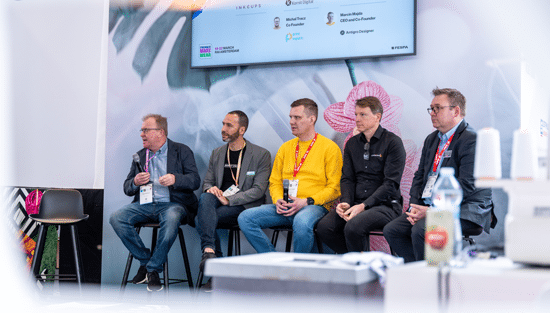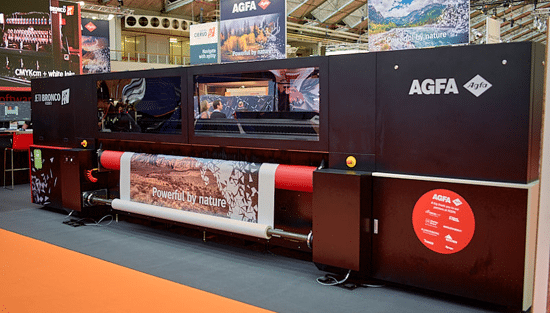The rise of AI in fashion production

We spoke to fashion-tech consultant Thomas Rothery about what artificial intelligence can do for design generation and forecasting retail trends.
Earlier this year, at the Sportswear Pro 2024 conference held at the RAI Amsterdam, thousands of people from across the globe were able to spend four days immersed in the future potential of the sports apparel industry.
One attendee and speaker at the event was fashion-tech consultant and former senior menswear designer at FILA, Thomas Rothery. For Thomas, the future of sportswear and the fashion industry generally – and the topic he spoke about as a guest on a panel discussion – is very much connected to artificial intelligence (AI).
“One of the topics we covered during our Sportswear Pro panel was the ideation process,” Thomas said.
“In creative design, ideation is ideas generation for the design process. For this, there are some really good AI tools. For example, with a company like FILA or Adidas, you could take a selection of products from the brand’s back catalogue and basically train an AI model to generate new products based on those inputs. Therefore, it would create designs that you wouldn’t have thought of, but they would be cohesive with the brand identity.
“Some of these AI models are very sophisticated and you can add extra prompts. For example, you could say ‘Art Deco-inspired’, and it will combine your brand style with a bit of another influence. It can help you generate ideas much quicker than you would as a human.
“In fact, you can also create the same of design for your advertising and marketing content. One of my co-panellists – Ian Campbell Cole, a friend of mine who is a designer and lecturer at Nottingham Trent University – organises workshops where he creates a Hermès-style marketing package using beautiful images that AI has generated. That might ordinarily cost hundreds of thousands of pounds requiring top models and photographers but with AI, it’s just half a day’s worth of work, once you know what you’re doing.”
Limited use, unlimited potential
Nevertheless, people are wary of AI’s potential downsides. While Thomas doesn’t dismiss the wider societal risks of increasingly powerful AI, for those working in design and printing, he says it’s important to view our more limited use of AI as just a tool.
Trend forecasting is another interesting area where machine learning can help spot future developments
“I think of AI a bit like when the first calculator came out. It’s a case of getting the sums and maths out of the way so that you can start doing the analysis, the bits of the job that aren’t just adding and subtracting. AI is just another bit of technology that offers certain benefits in terms of ideas generation, whereas, as humans, there are certain jobs that we are better at,” he says.
However, AI can do more than just idea generation: trend forecasting is another interesting area where machine learning can help spot future developments.
“This is really fascinating, and this is something that’s developing all the time,” Thomas says.
“At the last meeting I had with a company called Heuritech – a French company that has been working in AI for a long time, long before it became fashionable – they showed an image recognition technology which looks at millions of social media images every day and then tracks various identifiable features in those images.
“For instance, if red sweaters start to appear on more influencer and social media accounts, Heuritech can predict that red sweaters will have a bumper time in the market at a certain time period. Therefore, companies will want to include the trends that this technology highlights into their ranges.”
First steps
With the potential uses of AI being seemingly unlimited and already being used by many businesses in the industry, how can FESPA members start using this technology?
“AI 101 would be to start using Midjourney and exploring it. It is good fun, and is amazing. It’s a little bit like going into a photographic darkroom for the first time, but instead of the miracle image from light and chemicals, this is one from the words you have used. You have created a design with the help of some wizardry behind the scenes. With that, you can get an understanding of what’s possible,” Thomas says.
Beyond Midjourney, it’s then worth looking at what other key people in the sector are doing.
“Printing is such a massive industry but it’s worth looking at how different brands are using AI because there are plenty of opportunities for partnership and pushing things forward,” Thomas says.
“Then, at step three, with a good understanding of where it could go, you need to start working towards the idea of developing a one-of-one manufacturing process at an affordable price. As people want to make AI products and individualised products, one-of-one will become a huge factor.”
AI stormtroopers
Finally, to avoid a Rise of the Machines-style fashion Armageddon, it’s important to realise that our humble human talents aren’t yet totally redundant.
“We have to make sure that we are not encouraging laziness; we need to teach students to use AI as a tool, not as a crutch. We still need to use our human capabilities to reduce errors as much as possible,” Thomas says.
We need to make sure that humans remain in charge of quality control, overseeing processes and output
“As things get more sophisticated, the ability to reduce those errors will get ever harder. If there is one error in 10, we can spot that. If there is one error in 100, we can try to notice that too. When it’s one error in 10,000, it’s almost impossible to check. But that one error, if you leave it to AI, could have dreadful repercussions.
“A simple example would be the image of Nazi stormtroopers that was generated by Google’s Gemini AI, where the soldiers were racially diverse. A human would not make that mistake. Therefore, we need to make sure that humans remain in charge of quality control, overseeing processes and output, because there are many costs downstream in the manufacturing stages if you miss a problem at the design stage.”
Become a FESPA member to continue reading
To read more and access exclusive content on the Club FESPA portal, please contact your Local Association. If you are not a current member, please enquire here. If there is no FESPA Association in your country, you can join FESPA Direct. Once you become a FESPA member, you can gain access to the Club FESPA Portal.
Recent news

The personal touch: visit Personalisation Experience’s SmartHub Conference 2025
Join the SmartHub Conference at Personalisation Experience next month to stay ahead of the latest tech and trends.

How to build brand trust using customer reviews
Reviews can benefit or damage your business’s reputation. From spreading the word to social proof, here is why reviews matter and what you can do to manage your customer reviews to improve your brand’s reputation.

Regulation guidance: Extended Producer Responsibility
Extended Producer Responsibility (EPR) is now in effect. What does it mean for those in the print industry? Sustainability consultant Rachel England outlines everything you need to know.

How to maximise the automation of your production workflow
Workflow automation has evolved beyond basic file prep, now encompassing job submission, prepress, and postpress. Printers automate to boost productivity, cut waste, and address skill shortages. Implementing tailored automation, from RIPs to MIS, optimises throughput and profitability, minimising human intervention.